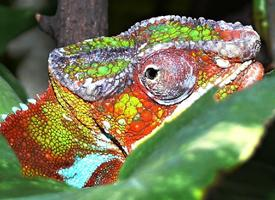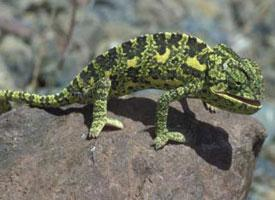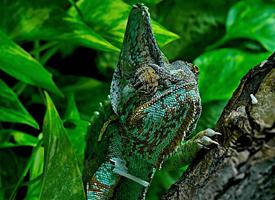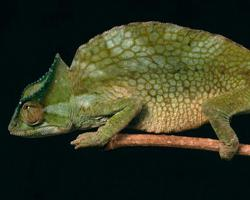
Váhy a míry
| Délka | od 35 do 50 cm |
|---|
Biologická data
| Délka života | 8 r |
|---|
Popis zvířete
The Panther Chameleon (Furcifer pardalis) is a strikingly beautiful and highly distinctive species of chameleon, native to the tropical forests of Madagascar. Renowned for their vibrant colors and the ability to change hues, these reptiles are among the most visually captivating creatures in the reptile kingdom. They have captured the fascination of herpetologists, hobbyists, and wildlife enthusiasts alike due to their unique physical characteristics and intriguing behaviors.Adult Panther Chameleons can reach lengths of up to 20 inches (about 51 cm) for males, with females being slightly smaller. They exhibit sexual dimorphism, not only in size but also in coloration. Males are more vibrantly colored than their female counterparts, displaying a kaleidoscope of colors ranging from blues, reds, and greens to more subtle shades of orange, pink, and yellow depending on their geographic location, mood, and health status. Females, on the other hand, are generally tan or brown with hints of pink or orange, especially when gravid (pregnant).
The body of the Panther Chameleon is laterally compressed, aiding in camouflage among the branches and leaves of their habitat. Their zygodactylous feet – two toes facing forward and two backward – are perfectly adapted for a life spent in the trees. These specialized feet, along with a prehensile tail, provide excellent grip and maneuverability through the dense foliage.
One of the most fascinating features of the Panther Chameleon is its eyes. Each eye can move independently, allowing them to have a 360-degree view of their surroundings. This remarkable adaptation helps them spot potential prey and predators more effectively. When a target is located, they can focus both eyes in the same direction, giving them accurate depth perception to strike at insects with their long, sticky tongues with incredible precision.
The skin of the Panther Chameleon is covered in specialized cells called chromatophores, which allow the chameleon to change its color. This ability is influenced by several factors, including environmental conditions, the presence of predators or competitors, and the chameleon's physiological condition. Contrary to popular belief, chameleons don't change color to match their background but rather to communicate with other chameleons, regulate their body temperature, or express their mood.
Breeding in Panther Chameleons involves vivid displays of color and posturing by the males to attract females and deter rivals. After mating, the female will lay a clutch of eggs, which she buries in a moist, sandy hole. The eggs undergo a lengthy incubation period, which can vary significantly depending on temperature and humidity levels.
In their natural habitat, Panther Chameleons are arboreal, spending most of their time in trees and bushes where they hunt during the day. Their diet primarily consists of insects, but they have also been known to consume smaller vertebrates on occasion. They rely on their stealth and patience, waiting motionlessly for unsuspecting prey to come within striking distance.
Despite their popularity in the pet trade, Panther Chameleons require careful and knowledgeable husbandry to thrive in captivity. They are sensitive to their environment, needing precise temperature gradients, humidity levels, and UVB lighting to maintain their health. Additionally, their natural behaviors and dietary needs must be accommodated to keep them stress-free and healthy.
The Panther Chameleon is a symbol of the rich biodiversity of Madagascar and a reminder of the fragility of its ecosystems. Habitat loss, deforestation, and the pet trade pose significant threats to their populations in the wild. Conservation efforts and sustainable practices are essential to ensure that these mesmerizing creatures continue to thrive in their natural habitat for generations to come.
Podobná zvířata
Nové fotografie zvířat
Top 10 zvířat
- Chinese water dragon (Physignathus cocincinus)
- Galápagos tortoise (Geochelone nigra complex)
- Dolphin gull (Leucophaeus scoresbii)
- Japanese macaque (Macaca fuscata)
- Colombian red howler (Alouatta seniculus)
- Sea urchins (Echinoidea)
- Moustached guenon (Cercopithecus cephus)
- Diana monkey (Cercopithecus diana)
- Common reed warbler (Acrocephalus scirpaceus)
- Common house mosquito (Culex pipiens)


